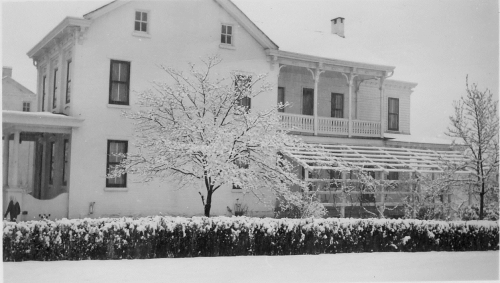 The John Updike Childhood Home at 117 Philadelphia Ave. in Shillington, Pa. is the place where Pulitzer Prize-winning novelist John Updike said his “artistic eggs were hatched.” He lived in the house from “age zero” to 13—from 1932 until 1945, when his family moved to the Plowville farm his grandfather once owned, where his mother grew up.
The John Updike Childhood Home at 117 Philadelphia Ave. in Shillington, Pa. is the place where Pulitzer Prize-winning novelist John Updike said his “artistic eggs were hatched.” He lived in the house from “age zero” to 13—from 1932 until 1945, when his family moved to the Plowville farm his grandfather once owned, where his mother grew up.
Updike (b. March 18, 1932, d. January 27, 2009) wrote about the house and Berks County in his fiction, poetry, and essays. Shillington was renamed Olinger, while Reading was christened Brewer. At the time of his death Updike was hailed as America’s last great man of letters. He is best known for his “Rabbit” tetralogy—Rabbit, Run (1960), Rabbit Redux (1971), Rabbit Is Rich (1982), and Rabbit at Rest (1990)—in which he uniquely followed one middle-class everyman’s journey through life. The last two Harry “Rabbit” Angstrom novels won the Pulitzer Prize for Fiction, and Updike himself won every major award except the Nobel Prize. In 1989 he received the National Medal of Arts from President George H.W. Bush at a White House ceremony, and in 2003 he returned to the White House to accept the National Humanities Medal from President George W. Bush.
Updike wrote approximately one book every year, and other well-known titles include The Poorhouse Fair (a 1959 tribute to his maternal grandfather, based on a real fair at the poorhouse just two blocks from the Updike house), The Centaur (a 1963 tribute to his father, who taught math at nearby Shillington High School), Of the Farm (1965, in which he wrote about bringing a second wife to the family farm to meet his mother), Olinger Stories (which detailed life in Shillington and were collected and published posthumously in 2014), The Maples Stories (aka Too Far to Go, 1979, which chronicled his first marriage to Mary Pennington), and The Witches of Eastwick (1984), which was made into both a movie and two TV series.
Select Bibliography of Books by and about John Updike
The house at 117 Philadelphia Avenue has been known as the Shilling house, the Updike house, and the Hunter house, after its three most famous residents. Records indicate that it was built in 1884 on land owned by Shillington founder Samuel Shilling for his son, Howard, who married Amelia Stamm on June 22 of that year. The house was sold in 1891, presumably because Mrs. Stamm Shilling died unexpectedly at the young age of 26. Howard Shilling (1856-1943) was active in organizing the Borough of Shillington and served as Republican county committeeman of Cumru township, as a county and state delegate, and as Census Enumerator of Cumru Township in 1880 and 1890. He served in the Spanish American War and amassed a trove of Puerto Rican relics that he brought back and displayed in a brick house he built, after remarrying, elsewhere on Philadelphia Avenue—the street where his father also lived.
 Four owners later, on April 20, 1922, John Updike’s maternal grandparents, John F. Hoyer and Katie Z. Hoyer, bought the house at 117 Philadelphia Avenue for $8000, with money he made growing tobacco, according to family lore. Before that, they had lived for eleven years on their 80-acre Plowville farm, which, according to a deed on file, they sold on April 7, 1921. Later, before John Updike was born, they took in Wesley Updike and their daughter, Linda Grace Hoyer Updike, because the young couple was also struggling during the Depression. As John Updike later wrote, it was “a temporary situation that became permanent.” Pictured above is the house as it looked during Updike’s time.
Four owners later, on April 20, 1922, John Updike’s maternal grandparents, John F. Hoyer and Katie Z. Hoyer, bought the house at 117 Philadelphia Avenue for $8000, with money he made growing tobacco, according to family lore. Before that, they had lived for eleven years on their 80-acre Plowville farm, which, according to a deed on file, they sold on April 7, 1921. Later, before John Updike was born, they took in Wesley Updike and their daughter, Linda Grace Hoyer Updike, because the young couple was also struggling during the Depression. As John Updike later wrote, it was “a temporary situation that became permanent.” Pictured above is the house as it looked during Updike’s time.
On October 26, 1945, the grandparents sold the house at 117 Philadelphia Avenue and the Updike family moved back to the farm at Plowville that they once owned—at Linda Updike’s insistence. A traumatized Updike would later write about leaving the house in a famous essay titled “The Dogwood Tree: A Boyhood,” which was published in his first collection of essays, Assorted Prose.
The Hoyers sold the house to Winfield and Dorothy Hain, who never lived in the building and six months later, on April 30, 1946, sold the property to Dr. John S. Hunter and Grace G. Hunter. Hunter had recently returned from serving in the European Theater from 1943-1945, and since Grace and Dorothy were sisters it’s likely that the Hains bought the house for the Hunters and transferred ownership once the returning G.I. could raise the money. It was Dr. Hunter, a prominent and much-loved family practice physician, who built the one-story annex to the house. It contained three examination rooms (now office space rented to a tenant), a waiting room (repurposed as the museum’s education room), and an office (now the museum gift shop). Dr. Hunter also built an enormous cedar closet in the attic which left such an impression on Updike when he visited the house with his mother that he wrote about it in “The Black Room,” one of his short stories. Dr. Hunter was a graduate of West Reading High School, Wyomissing Technical Institute, Duke University, and Temple Medical School. During WWII he served as chief of the orthopedic section of the 10th Station Hospital, 116th General Hospital, and 67th Evacuation Hospital. Pictured below is a painting of the house as it looked when the Hunters lived there.
The Hunters occupied the house the longest—until April 1989, when they decided to move into The Highlands, a full spectrum retirement community. Two more families occupied the house after them, and then in November 1998 Ted Niemczyk and Tracy Hoffmann bought the property to use for their graphic design business. Both Updike fans, they invited the author to tour the house and got information about what each room was used for and what had changed. They gave John Updike Society members a special tour during the First Biennial John Updike Society Conference hosted by Alvernia University.
On April 27, 2012, the partnership dissolved and Niemczyk and Hoffmann offered the house to The John Updike Society after an attempt to sell it on eBay produced no bids (the asking price was $499,000 and the starting bid $249,000). The society eventually paid $180,000, given mechanical issues and exterior deterioration that needed immediate attention. The purchase was made possible because of a generous donation by The Robert and Adele Schiff Foundation, which continues to support the project. With borough approval, the society went ahead with their plans to turn the house into a literary site and museum.
On July 16, 2015, the society contracted R.J. Doerr Co. of Easton, Pa. to restore the house to 1932-45, the years that Updike lived there. Doerr’s resume included restoring the home of one of the signers of the Declaration of Independence.
On October 2, 2021, 300 people gathered in closed-off Shilling St. for a Pennsylvania Historic Marker dedication ceremony, the unveiling of a National Registry of Historic Places plaque, and grand opening of The John Updike Childhood Home—now a literary site and museum with 10 areas of exhibits that tell the story of John Updike and the influence that Berks County had on his work.





